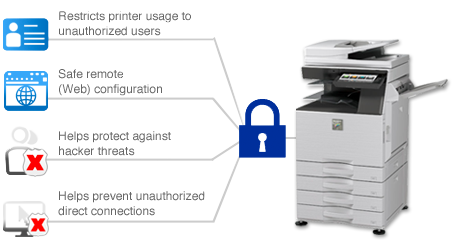What Is Secure Printing? 5 Essential Tips to Stay Safe
August 12th, 2019 by admin

A guide to privacy using secure print.
Just 44 percent of IT professionals feel their companies take steps to address printer security. The fact of the matter is that most people don’t recognize network printers as a security threat.
This may have been true in the past, but today’s printers are an easy entry point for cybercriminals. They have hard drives and network connections. Printers are more like computers and smartphones than ever.
That’s why more IT leaders and business owners need to make secure print solutions a top priority.
With this guide to privacy using secure print- five essential tips in hand, you can put printing security at the top of the queue for your company.
1. Manage Users Effectively
The most important part of your print security efforts is managing your employees. Over 90 percent of breaches are the result of human error. Your employees represent a major security threat.
Most of your employees aren’t trying to cause a breach. In the case of printing, they might print a copy of a confidential document, then leave it sitting on the printer.
In some cases, you may want to give an employee or a department access to a private printer. This way, you can be sure files remain confidential when HR needs to print documents.
Even with a private printer, there’s the issue of printer memory storage. Confidential documents might be stored in the printer’s memory. Without the right security in place, these documents could then be accessed.
There are several steps you can take to make sure your employees are printing in a secure way. The first is to train and educate them. Show them the procedures they should follow when they need to print a document.
Education also helps them understand the risks that printing presents. When they understand why printer security matters, they’ll be more likely to practice it.
You should also manage who has access to the printer. You can create accounts with certain printing privileges. Employees who need to print confidential documents will need clearance to do so.
2. Invest in Your Hardware
Another factor to consider in secure printing is the printer itself. You should know where each device on your network came from. This is especially important if you have rental equipment.
Take stock of the security features your printer has. Most of today’s models come with security features designed to protect your network.
You should install a firewall that will only let trusted IPs connect to your printers. You can also set a password on network access. This limits the devices that can connect to the printer.
Also, limit printing to your local network.
As noted, another potential risk is documents stored in the printer’s memory. Most printers have security settings that let you erase confidential documents from the printer’s memory.
If your printers don’t have these security features, it might be time to upgrade.
Finally, don’t forget about the placement of the equipment. Printers should be placed in areas that are easy to watch. This makes it simple to track who is accessing the printer.
3. Use the Right Software Tools
Another tip for how to secure print jobs in your business is to make sure you’re using the right software tools.
Software can be more cost-effective than installing separate, private printers for confidential documents. This is often true in larger organizations. Many employees may need to handle sensitive information and documents.
Software tools allow these employees to share a printer with others. At the same time, the programs maintain security.
Secure print software has settings that put print jobs into a holding pattern. They require the entry of a PIN or access code at the printer.
This means the person ordering the print has to be there to enter the code. Without it, the printer won’t complete the job.
This feature prevents documents from being left where anyone could pick them up. As an added bonus, it can reduce waste. Many users never claim print jobs, which means the job won’t be printed.
4. Check Your Security
You likely track security for the software you run on your computers and other devices. If you have a procedure in place, you probably complete vulnerability assessments for your networks.
You should also keep on top of security updates. When you do find vulnerabilities, you should be working to patch them.
So why aren’t you doing the same for your printers? Printers also run on software, which may need to be updated or patched from time to time.
No programming is iron-clad. Regular testing and updates can help you keep your printer more secure.
Essentially, you should integrate your printers and other hardware into your security protocols. The more potential access points you can secure, the safer your business will be.

5. Get Help with Secure Print Solutions
Cybersecurity is an important task in every business, but it's a growing field. Many IT departments are struggling with it. As more devices are added to networks, it becomes more difficult to control them all.
That’s probably one reason printers are often overlooked. They seem low-risk compared to your employees’ smartphones. Your IT team has more important things to worry about.
That’s why you should consider working with a third party. They can improve not just printer security, but security in your business as a whole.
An expert partner can help you find the right security features or choose the right software. They can also help you integrate printers into the network securely. Finally, they can provide assistance with monitoring and patching.
Better Security Today
From this guide to privacy using secure print, it should be clear why secure print solutions are necessary for your business. The good news is that it’s often easier than you think to make your printers and your network as a whole more secure.
If you’re wondering how you can improve security for your business, get in touch with us. We have the expertise to help you design a solution that fits your business.
Posted in: Solutions